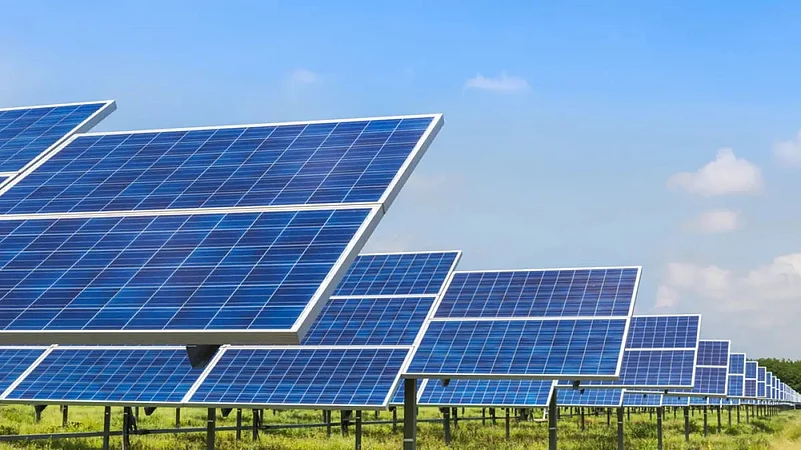According to a report titled 'Landscape of Green Finance in India 2022', published by the Climate Policy Initiative, India's green financing is far short of the country's current needs. The data shows that inflows of funds in green projects were $44 billion (Rs 309,000 crore) in 2019-2020, representing about 1/4th of the total green finance needs.

According to the Paris Agreement, India needs around $2.5 trillion in green financing between 2015 and 2030 to achieve Nationally Determined Contributions (NDCs) under the deal, roughly $170 billion per year.
"India needs approximately Rs 162.5 lakh crore ($2.5 trillion) till 2030 for NDCs and Rs 716 lakh crore ($10.1 trillion) to achieve Net-Zero emissions by 2070. By conservative estimates, the current tracked green finance in India represents approximately 25 per cent of the total requirement across sectors just to meet the NDCs," the report noted.
In 2021, India announced its enhanced climate action - Panchamrit targets, which include adding 500 GW of non-fossil fuel-based energy capacity and meeting 50 per cent of its energy requirements through non-renewable sources.
The report noted that "enhanced ambition requires mobilisation of green finance at a much faster pace."
However, there has been an increase in green financing in India. The public sector green financing increased by 179 per cent, and the private sector saw a jump of 130 per cent. "This shows increased commitment from public sources – both domestic and international. However, given the need and ambition, the report said that "private sector finance mobilisation must significantly outpace public sector finance" in the coming years.
Some Other Trends Captured
The report tracked both public and private sources of green capital inflows from India and abroad "right from the source to the end beneficiaries through different instruments".
Domestic Green Finance Trend
The document noted that domestic sources accounted for the majority of green finance needs, with about 87 per cent share in the financial year 2019 and 83 per cent in the financial year 2020.
Further elaborating on the domestic green financing trend, the report noted that the private sector contributed about 59 per cent ($22 billion or Rs 156.9 thousand crore), and the rest were from the public sector.
Within the public sector, the government (both central and state) contributed 54 per cent, while the public sector enterprises allocated 46 per cent of the budgetary allocation towards green finance.
International Green Finance Inflows in India
The report noted that green finance accounts for only 3 per cent of the total foreign direct investment (FDI) inflow to India. However, the share of "international sources increased from 13 per cent in the financial year 2019 to 17 per cent in the financial year 2020. Public sources (Official Development Assistance (ODA) and Other Official Flows (OOF) accounted for 60 per cent of international finance over the two-year period," the report said.
Further, FDI inflows in India's green finance increased substantially from 2016-2018 and reached about Rs 9000 crore ($1.2 billion) in 2020.

Green Finance Investment Sectoral Destinations
The report noted that the total green fund flow was almost equal between clean energy (42 per cent) and energy efficiency (38 per cent) segments; however, clean transport got about 17 per cent of green funds.
Clean Energy Sector
Investments in the clean energy sector were almost equally split between public and private sources. However, domestic inflows were at 82 per cent, and international inflows were at 18 per cent. Of the 82 per cent domestic inflows, PSUs contributed 35 per cent.
The report also highlighted which project received the greatest share of green financial investments. For example, it was found that 'solar projects' received Rs 54,000 crore and accounted for 41 per cent of the total finance flows in the clean energy sector in the financial year 2019-2020.
Energy Efficiency Sector
Green finance inflows to the energy efficiency sector were primarily from the private sector at 91 per cent. However, apart from this trend, the report also captured data that showed that the domestic "fund inflows at 96 per cent were far greater than international flows at 4 per cent."
The report also noted that finance flows to the energy efficiency sector increased by 26 per cent from the financial year 2019 to the financial year 2020. However, the report pointed out that the fund flows to process efficiency and green buildings decreased by 83 per cent and 81 per cent, respectively, in the financial year 2020.
The report said, "these drops may be attributed to changes in the design of the scheme run for process efficiency by the Government of India (GoI), the onset of Covid, and variation in the size of projects in the case of green buildings."
Clean Transportation
Regarding green funding in the transportation sector, the report said the public sector accounted for 96 per cent of the financing at Rs 58,000 crore for the financial year 2019-2020.
Another interesting finding highlighted in the report was that domestic green finance inflows were at 72 per cent, and international inflows were at approximately 27 per cent, of which 99 per cent came from international public sectors.
Regarding the projects that received the highest green finance inflow in the clean transportation sector, the report found that the mass rapid transit system (MRTS) got over 87 per cent of the total funds in this sector.
Electric vehicle projects (EVs) received less than 1 per cent of the total fund flows; however, the funds received were higher by 80 per cent than previously.














